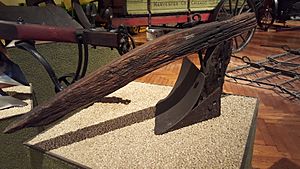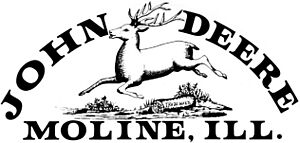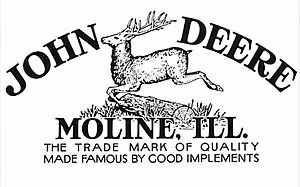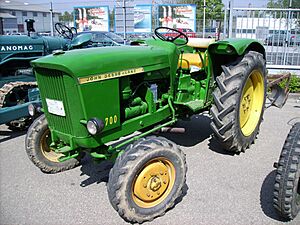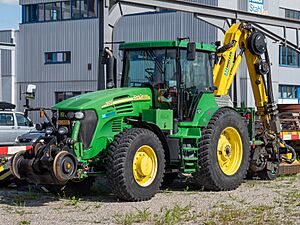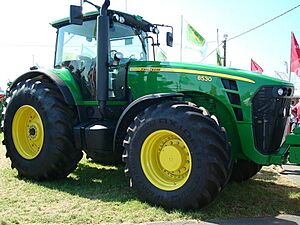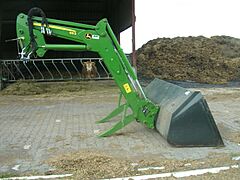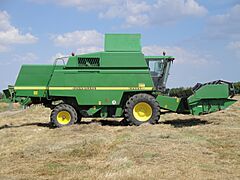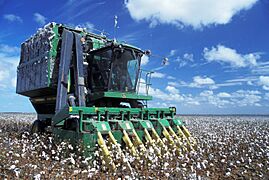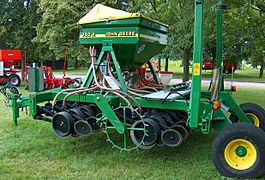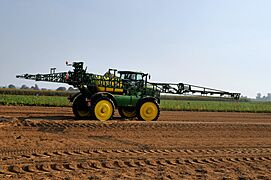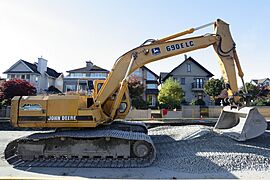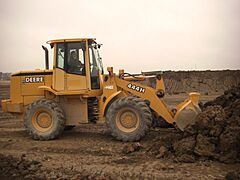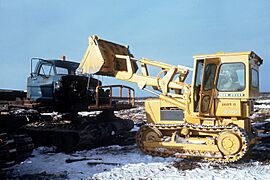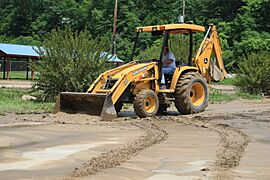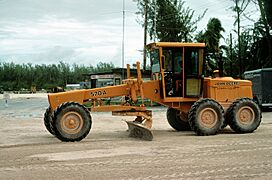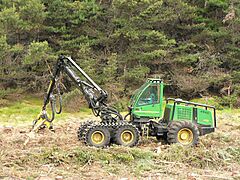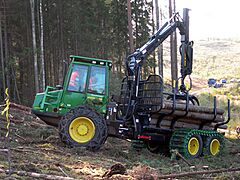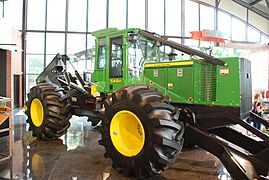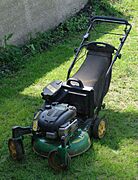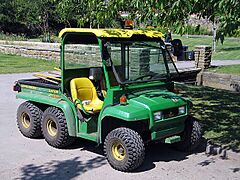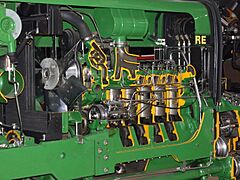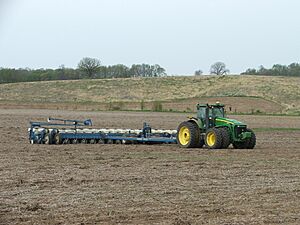John Deere facts for kids
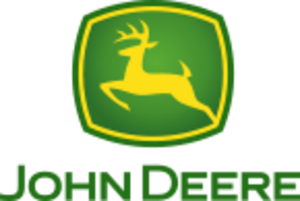 |
|

John Deere World Headquarters in Moline, Illinois
|
|
| Public | |
| Traded as | |
| Industry |
|
| Founded | 1837, in Grand Detour, Illinois, U.S. |
| Founder | John Deere |
| Headquarters |
,
U.S.
|
|
Area served
|
Worldwide |
|
Key people
|
John C. May (chairman, CEO & president) |
| Products |
|
| Services | Financial services |
| Revenue | |
|
Operating income
|
|
| Total assets | |
| Total equity | |
|
Number of employees
|
75,800 (2024) |
| Subsidiaries | Nortrax, Vapormatic, Hagie, Monosem, Blue River Technology, Harvest Profit, Navcom Technology, OnGolf, Lesco, Unimil, John Deere Financial, Bear Flag Robotics |
| Footnotes / references Financials as of October 27, 2024[update] |
|
Deere & Company, also known as John Deere, is an American company. It makes many kinds of machines for farms, construction, and forestry. They also make diesel engines and parts for heavy equipment. The company also helps people with money services.
John Deere is listed on the New York Stock Exchange. Its famous slogan is "Nothing Runs Like a Deere." The company's logo shows a leaping deer with the words "John Deere." This logo has been used for over 155 years. The main office is in Moline, Illinois.
In 2022, John Deere was ranked 84th on the Fortune 500 list. This list shows the largest companies in the United States.
Contents
History of John Deere
Starting in the 1800s
The company began with John Deere. He was born in Rutland, Vermont, in 1804. In 1836, he moved to Grand Detour, Illinois, to start fresh.
John Deere was a skilled blacksmith. In 1837, he opened a shop in Grand Detour. He fixed things and made tools like pitchforks and shovels.
His most important invention was the self-scouring steel plow in 1837. Before this, farmers used plows made of iron or wood. The rich soil of the Midwest would stick to these plows. Farmers had to stop often to clean them. John Deere's plow had a smooth, polished steel surface. This allowed the soil to slide off easily. This invention made farming much easier in the American Great Plains. It helped many people move there.
At first, John Deere made plows only when someone ordered one. This was very slow. He soon realized he needed to make plows before they were sold. This way, customers could see the plows and buy them right away. News of his great plows spread quickly.
In 1843, Deere partnered with Leonard Andrus. They built a new factory by the Rock River in Illinois. This factory used water power for its machines. It made about 100 plows in 1842 and 400 plows the next year.
Deere's partnership with Andrus ended in 1848. Deere moved to Moline, Illinois, to be closer to the railroad and the Mississippi River. There, he started a new partnership with Robert Tate. They built a factory that same year. Production grew fast. By 1849, the company was making over 200 plows each month.
John Deere bought out Tate's interest in 1853. His son, Charles Deere, joined the business. The company now made many farm tools, not just plows. These included wagons and corn planters. By 1857, they made almost 1,120 tools every month.
In 1858, a financial problem hit the country. To avoid going out of business, the company changed how it was run. John Deere gave control to his son-in-law, Christopher Webber, and his son, Charles Deere. Charles took on most of the management duties. John Deere was president until he retired in 1886. He passed away a month later.
The company became "Deere & Company" in 1868. Charles Deere was in charge. In 1869, he started setting up sales centers and independent stores across the country. That same year, Deere & Company won an award for "Best and Greatest Display of Plows" at the Illinois State Fair.
While focusing on farm tools, John Deere also made some bicycles in the 1890s.
Growing in the 1900s
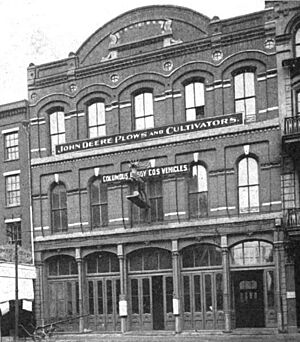
In the early 1900s, competition grew. John Deere decided to make more types of farm tools. But making gasoline tractors became the most important part of their business.
In 1912, William Butterworth became president. He started the company's move into tractors. John Deere tried making its own tractors, but then bought the Waterloo Gasoline Engine Company in 1918. This company made the popular Waterloo Boy tractor. John Deere kept selling tractors under the Waterloo Boy name until 1923. That's when the John Deere Model D was introduced. Today, many John Deere tractors are still made in Waterloo, Iowa.
The company made its first combine harvester in 1927. It was called the John Deere No. 2. A year later, they made the smaller John Deere No. 1, which was very popular. By 1929, newer, lighter harvesters replaced these models. In the 1930s, John Deere developed combines that could harvest grain on hillsides.
During the Great Depression, John Deere did something special. The company never took back any equipment from American farmers who were struggling.
During World War II, John Deere helped with the war effort. They made military tractors, parts for tanks, aircraft parts, and ammunition.
In 1947, John Deere introduced its first self-propelled combine, the Model 55. Other models followed, like the 40, 45, 95, and 105. In the mid-1950s, they added a corn head. This allowed farmers to pick, shell, and clean corn all at once with their combine.
In 1956, Deere & Company bought a German tractor maker called Heinrich Lanz AG.
In 1958, John Deere built a factory in Argentina. They made many tractor models there until 1994. In 2011, the Argentinian plant started making tractors again. They also began assembling combine harvesters in 2012.
On August 30, 1960, John Deere held a huge event called "Deere Day in Dallas." Dealers from all over the world came to Dallas, Texas. They saw the "New Generation of Power," which were the company's first modern four-cylinder and six-cylinder tractors. This event was a big deal, with high-tech presentations and live demonstrations.
Before this, John Deere had focused on two-cylinder tractors. The new "10" series tractors (models 1010, 2010, 3010, and 4010) were much more powerful. They were also easier and more comfortable to use. The 4010 was very powerful for its time. It led to the 4020, which is one of the most popular tractors John Deere ever made. These new tractors helped John Deere become the top farm equipment maker in the United States by 1964.
In 1972, Deere introduced its "Sound Idea Tractors." These tractors had a new, comfortable cab called the Sound Gard body. It was insulated and had heating, air conditioning, and even an optional radio. Later models in the 1980s, like the "Iron Horses" series, had even more improvements.
In 1983, Deere introduced the 4050 series. These tractors had a new 15-speed PowerShift transmission. They also offered optional mechanical front-wheel drive for better grip and turning. These were followed by the 55 and 60 series, and then the completely new 7000 and 8000 series in the early 1990s.
In 1962, John Deere had 35,000 employees, with 9,000 in Illinois. The main office was in Moline, Illinois. They had six factories around Moline and one in Hoopeston, Illinois. These factories made different farm tools and parts.
In 1969, John Deere introduced a "New Generation of combines." These included the 3300, 4400, 6600, and 7700. They were the first to have easy-to-attach headers. In the 1980s, updated versions like the 4420, 6620, 7720, and 8820 came out.
In 1989, Deere launched the "Maximizer" combines. These were completely new designs with a different cab and engine placement. Also in 1989, John Deere was added to the National Inventors Hall of Fame. In 1997, Deere celebrated 50 years of making self-propelled combines. In 1999, they introduced the 50 series Maximizer combines. These had a new look and improved features.
John Deere also introduced the Single-Tine Separation (STS) system in 1999. This was a big step forward in rotary combine technology. It used less power and handled materials better.
John Deere in the 2000s
In 2014, the Smithsonian Museum recognized John Deere's original plow design. They called it one of the objects that changed American history.
As of 2018, Deere & Company had about 67,000 employees worldwide. Half of them were in the United States and Canada. It is the largest farm machinery company in the world. In 2014, the company had to lay off some workers because there was less demand for its products.
John Deere's main locations in the U.S. are its World Headquarters in Moline, Illinois, and factories in the central and southeastern United States. As of 2016, the company was experimenting with electric farm tractors.
The leaping deer logo has been used for over 155 years. It has changed a little over time. Some old logos show the deer jumping over a log. The company uses different logo colors for farm products versus construction products. Farm products are green with a yellow border. Construction products are black with a yellow deer and border.
In September 2017, Deere & Company bought Blue River Technology. This company uses machine learning in farming. Their technology helps farmers spray only where weeds are present, which means using less weed killer.
In August 2019, John May became the new CEO and president of John Deere.
In October 2021, about 10,000 employees who were part of a union went on strike. This happened because they couldn't agree on a new contract.
In January 2022, the company showed off a self-driving tractor at a big technology show. It's made for large farms to make farming faster and more efficient. John Deere wants to connect many machines to its cloud-based "John Deere Operations Center."
In June 2022, Deere announced it would stop making its model 3710 plow. However, it would continue to offer its model 995 plow.
In July 2024, Deere announced it would lay off 600 employees in its Midwest factories. They are also thinking about moving some production to Mexico.
Repairing John Deere Equipment
Newer John Deere farm equipment has been talked about because it can be hard for owners or other repair shops to fix. Only John Deere can access the special computer code needed for repairs. This means that if a machine breaks, only John Deere can fix it.
John Deere's rules for the software inside their tractors do not allow farmers or independent mechanics to change it. This can make it hard for farmers to do their own repairs. Some groups have said this is not fair and goes against the "right to repair." Some farmers have found ways to get around these rules to fix their machines. In February 2022, a bill was introduced in the U.S. Senate to help farmers do their own repairs. By April 2022, similar bills were being discussed in 26 states.
On January 9, 2023, John Deere signed an agreement with the American Farm Bureau Federation. In this agreement, John Deere said it would let farmers and independent repair shops buy access to its software, manuals, and other repair information. However, some people were still unsure about this agreement. They pointed out that it's not a law and John Deere could change its mind. Also, as part of the agreement, the Farm Bureau agreed not to support new laws about the "right to repair."
This issue is still a problem for John Deere users in other countries, like Australia. In Australia, farm machinery is not covered by their first "right to repair" law. Farm groups there are working to get laws passed that cover farm equipment.
Legal Issues About Repair Rules
In June 2022, 13 lawsuits from farms and farmers were combined into one case in federal court in Illinois. These lawsuits claimed that John Deere and its dealers worked together to control the market for repairing John Deere equipment. In February 2023, the U.S. Department of Justice supported the farmers in the case. They said that limiting repairs can hurt both customers and the public. In November 2023, a judge allowed the case to move forward. The judge said there was enough evidence to suggest that "Deere has the ultimate control of the repair services market."
In January 2025, the Federal Trade Commission (FTC) filed a lawsuit against John Deere. The FTC said that John Deere's rules made repair costs higher for farmers by stopping independent shops from fixing their equipment. Five U.S. states, including Michigan and Wisconsin, joined the FTC in this lawsuit.
John Deere Products
John Deere makes many different products.
Farm Equipment
Farm products include tractors, combine harvesters, cotton harvesters, balers, planters, sprayers, and grain carts.
-
Tracked tractor (9630T)
Construction Equipment
Construction equipment includes:
Forestry Equipment
John Deere also makes many machines for forestry. These include harvesters, forwarders, skidders, and log loaders.
Other Products
Other products include lawn mowers, small utility tractors, snow throwers, snowmobiles, all-terrain vehicles (ATVs), and GPS systems. They also supply diesel engines and parts like axles and transmissions for heavy machines.
John Deere also offers loans for things other than equipment. As of 2017, this was a very important part of their business.
John Deere Factories
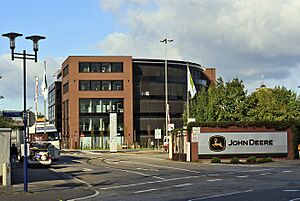


John Deere has many factories around the world. Some major ones in North America include:
- Harvester Works in East Moline, Illinois (makes large combine harvesters)
- Davenport Works in Davenport, Iowa (makes wheel loaders, motor graders)
- Dubuque Works in Dubuque, Iowa (makes backhoes, crawlers)
- Waterloo Works in Waterloo, Iowa (makes tractors, cabs, engines)
- Horicon Works in Horicon, Wisconsin (makes lawn and garden equipment)
Other important factories are in:
- Granadero Baigorria, Argentina (engines, tractors, combines)
- Pune, India (tractors)
- Mannheim, Germany (tractors)
- Joensuu, Finland (forestry equipment)
Subsidiaries and Related Companies
John Deere owns or works with several other companies:
- Bear Flag Robotics: Focuses on self-driving farm technology.
- John Deere Financial: Provides money services.
- Kemper: Makes headers for harvesters.
- Waratah Forestry Attachments: Makes parts for forestry harvesting.
- Blue River Technology: Uses computer vision and robotics for farming.
- Wirtgen Group: A large company that makes construction equipment.
Green Magazine
Green Magazine is a magazine for people who love John Deere. It started in November 1984. The first issue had 10 pages and was sent to 135 people. It talked about tractors, had letters from readers, and ads.
The magazine grew quickly and became a monthly publication in 1990. Today, it has about 30,000 readers. It usually has 88 colorful pages. It includes articles about restoring old tractors, new models, and other interesting topics for John Deere fans.
Leadership
Presidents
- John Deere, 1869–1886
- Charles Henry Deere, 1886–1907
- William Butterworth, 1907–1928
- Charles Deere Wiman, 1928–1942 and 1944–1955
- Burton F. Peek, 1942–1944
- William Alexander Hewitt, 1955–1964
- Ellwood F. Curtis, 1964–1978
- Robert A. Hanson, 1978–1985
- Boyd C. Bartlett, 1985–
Chairmen of the Board
- William Alexander Hewitt, 1964–1982
- Robert A. Hanson, 1982–
See also
 In Spanish: Deere & Company para niños
In Spanish: Deere & Company para niños
- John Deere Buck
- John Deere World Headquarters
- List of John Deere tractors
- History of agriculture in the United States § John Deere plows


